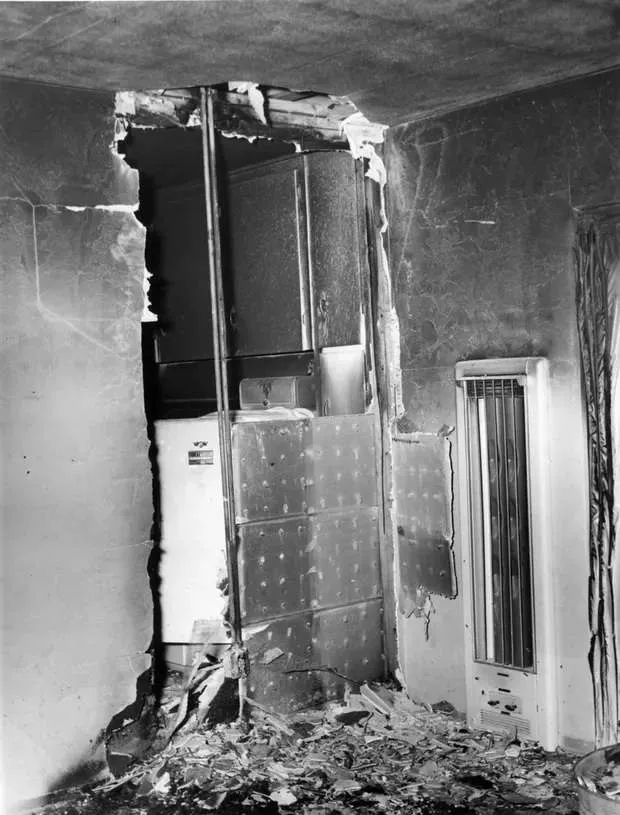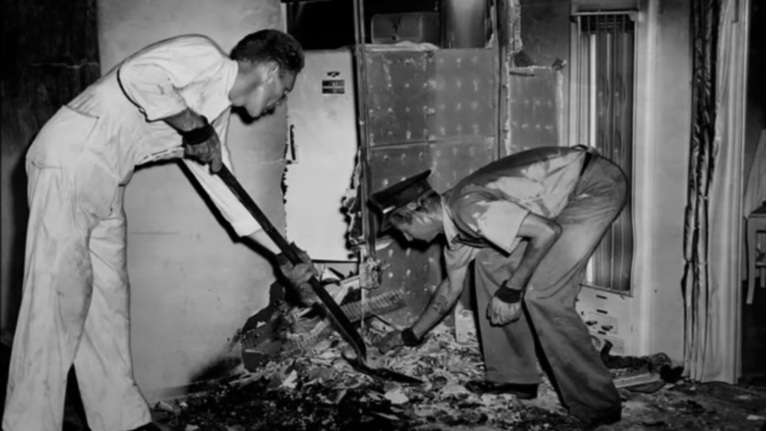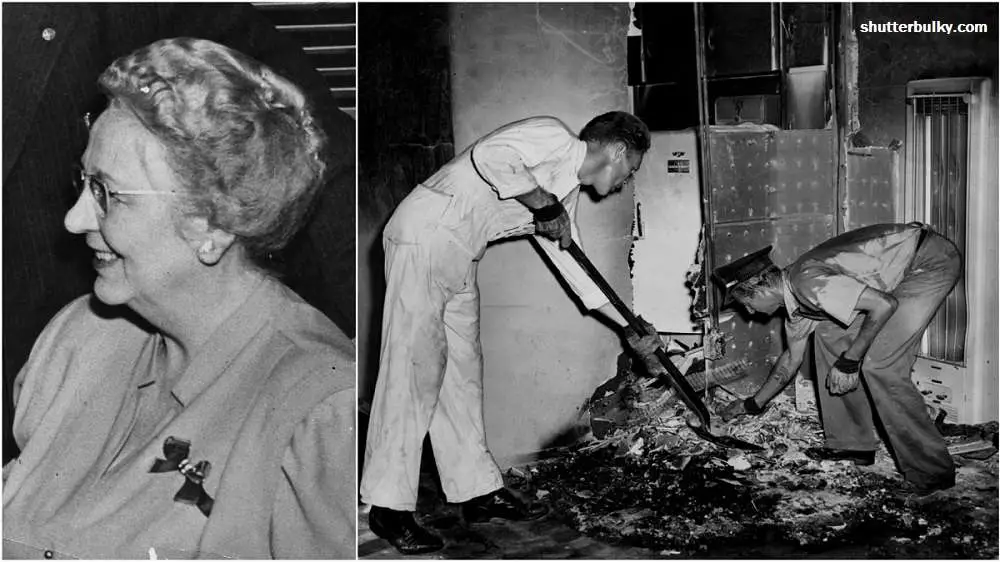On July 2, 1951, Pansy Carpenter, a St. Petersburg resident, went to send a telegram to her 67-year-old neighbor, Mary Hardy Reeser, on July 2, 1951. She called the cops after discovering the doorknob to the flat at 1200 Cherry Street was hot to the touch. The horror they discovered in that flat sparked an investigation that would last decades.
What You Should Know about Mary Hardy Reeser death?
- Mary Hardy Reeser died in 1951 in St. Petersburg.
- She was said to have died as a result of spontaneous human combustion.
- The cause of death was determined to be accidental by an FBI inquiry, but the case continues to raise issues to this day.
A widow named Mary Hardy Reeser slid into a nightgown and popped two sleeping pills before sinking into the oversized easy chair in the midst of her St. Petersburg apartment. The open windows let in the hot summer air.
On July 1, 1951, it was around 9 p.m. She had just kissed Dr. Richard Reeser Jr., Reeser’s only son, farewell after a visit. She had decided to have a cigarette before going to bed because she was alone for the night.
Reeser, who was 67 at the time, was never seen alive again. The door to Reeser’s modest apartment on 1200 Cherry Street Northeast was heated, and the handle was too hot to touch when the landlord, Pansy Carpenter, tried to deliver a telegram the next morning. The embers still crackled inside the scorched walls.
Firefighters entered a smoke-filled apartment packed with soot. Only a clump of black ashes remained after Reeser had vanished.
Police discovered coil springs from the chair, as well as a portion of Reeser’s backbone, among the rubble. Her left foot, encased in a black silk slipper, nestled in the pile. Her head had “shrunk to the size of a cup,” according to accounts.
It was one of the first times that national law enforcement looked into a possible case of spontaneous human combustion.
Since then, the event has been covered by the media, discussed online, and made the topic of “dramatic re-enactments” and gravelly-voiced narrators on television shows.
Extreme heat was discovered by firefighters. Puddles of molten wax were surrounded by bare candle wicks. The tops of the walls were discolored with smudges of smoke. The room was lined with crooked electric switches.
Lower down, the walls were clean, and the electrical switches appeared to be in good working order. The newspapers in Reeser’s office sat untouched. Her bed’s sheets were still white.
Reeser’s case is one of the most bizarre unsolved mysteries in Tampa Bay history. Magazine articles, films, and novels have all been written about the subject. But there are still unanswered questions.
How could a woman burst into flames without igniting the rest of the room? What could have been the cause of Mary Reeser’s death?
Dr. Richard Reeser, Sr. and Mary Reeser were from Columbia, Pennsylvania. She moved to St. Petersburg a few years after her husband died to be closer to her son and grandkids.
Reeser enjoyed stitching, socializing, and spending time with her family. However, Florida was too hot for her, and she missed her Pennsylvania pals.

On the last day he saw her, her son could see she was angry about it. She had been too concerned about returning home for supper.
The only thing in her system was the medicine she took before he left.
No one knew what to make of the situation. However, there were numerous suggestions.
Perhaps the fire started by mistake. It could have been a lightning strike. In 1951, one reader of the New York Times thought that Mary might have died of self-ignition (Spontaneous Combustion).
The last theory was the one that gained the most traction. St. Petersburg’s “cinder woman mystery” quickly garnered global headlines.
J.R. Reichart, the chief of the St. Petersburg Police Department, received hundreds of theories from amateur detectives. Some claim to have detected an unusual odor outside of Reeser’s house. Everything from the fabric of the chair cushion to napalm, phosphorus, and thermite bombs were blamed by conspiracy theorists.
One letter stated, “A ball of fire came through the open window and hit her.” “I was there when it happened.”
There was no definitive solution. As a result, Reichart wrote the Federal Bureau of Investigation a letter.
He wrote, “Dear Mr. (J. Edgar) Hoover.” “This fire is too perplexing for the small-town fire department to deal with.”
“Parts of the apartment rug, smoke samples, rubble from the walls and floor, and segments of the chair” were among the items sent to the FBI laboratory in D.C. by police. Reeser’s mysterious disappearance was investigated by FBI agents for three weeks.

Last but not least, on August 8, Reichart released a statement to the media in which he called the case “the most unusual case I’ve seen in my nearly 25 years as a police officer in the City of St. Petersburg.”
According to FBI agents, there was no evidence that Mary Reeser or the building had been struck by lightning. The apartment’s fuses were all still working. Investigators had also failed to find any substances that could have sparked the fire.
“Common combustible fluids and accelerants such as alcohol, gasoline, and other similar substances would almost certainly be consumed in such a fire, with no trace of them left behind,” Reichart said.
What about the possibility of spontaneous combustion? That was also ruled out by the investigation.
It’s possible that Mary Reeser dozed off in her chair while smoking her evening cigarette, drowsy from the sleeping pills she took. The rayon acetate nightgown she was wearing at the time of her death could have caught fire from cigarette ash.
Mary Reeser weighed around 170 pounds at the time. Human fat could have fueled a smoldering fire that allowed hot air and smoke to rise to the ceiling throughout the evening.
“Mary was a great smoker,” Mary Reeser’s daughter-in-law Ernestine Reeser told the St. Petersburg Times in 1991. “The cigarette slid down her sleeve into her lap.” Her fat was the source of her continual combustion. The chair was sitting alone on a cement floor. There was nothing to burn around her. “
Why is life insurance so important?
Maybe you’ve even shopped for coverage or have some life insurance through work. But do you really understand what life insurance is and what it can accomplish for you and your family? If you’re asking, “Why should I acquire? Read More >>>
The most plausible theory, according to the investigators, was that it was an accidental death. An anthropologist from the University of Pennsylvania, Wilton M. Krogman, disagreed.
Mary Reeser’s skull should have exploded instead of shrinking, he claims.
Then there was the matter of the body’s cremation, which would have required temperatures of several thousand degrees over several hours.
According to the York Daily Record, Krogman said, “I cannot conceive of such complete cremation without more burning in the apartment.”
Mary Reeser’s death has been a mystery for nearly 70 years. No one knows for sure what happened to this day. It’s possible that we’ll never know the answers.
After the FBI investigation ended, a portion of Reeser’s ashes were interred in Pennsylvania with her husband. The rest stayed in St. Petersburg with her children.
The St. Petersburg Times reported that Mary Reeser’s family used to feel her presence, at least until they got rid of her old furniture.
“It’s Grandma again,” says the narrator. “When a breeze blows by,” they used to say. “Don’t be concerned. She’s a nice lady. “
“To this day, I believe the FBI report given to St. Petersburg police in August 1951 is the most credible, if incomplete, explanation of the incident—that Mrs. Reeser’s own body fat provided the fuel for the fire that consumed her,” wrote Jerry Blizin, a former Tampa Bay Times columnist. “There was no “spontaneous human combustion,” nor was her death caused by lightning or chemicals, according to the FBI.”
So, what eventually happened to Mary Reeser? One of the strangest (cue gravelly voice) unsolved mysteries is likely to remain unknown.
All the information & photo credit goes to respective authorities. DM for removal pl.
Read More >>> Dick Proenneke : 30 Years Alone in the Alaskan Wilderness

